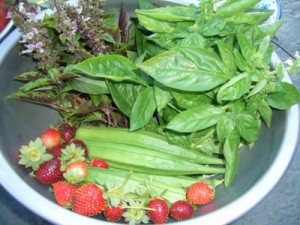Intensify your culinary adventure
Aromatic plants add flavor, can be grown year-round in our temperate climate
 Imagine eating spaghetti sauce cooked without basil, oregano, parsley or bay leaf. Or pico de gallo without cilantro. It just wouldn’t be the same.
Imagine eating spaghetti sauce cooked without basil, oregano, parsley or bay leaf. Or pico de gallo without cilantro. It just wouldn’t be the same.
Herbs bring the “BAM” to our culinary adventures, and the intensity and flavor of fresh herbs can’t be matched. Herbs are also playing a key role as health conscious cooks look to their flavors to replace salt and reduce the amount of sodium in today’s recipes.
People often wonder about the difference between herbs and spices, which is sometimes blurred. Herbs come from aromatic plants and are usually harvested from the plant leaves, though there are exceptions. Spices often come from more tropical zones and can come from the seeds, roots, berries or flowers of plants.
Our temperate climate allows us to grow herbs outside almost year-round in Central Texas, and of course they can be grown inside as well. Most herbs are easy to start from seed but many can also be purchased from local nurseries to grocery stores as starter plants to give you a jump on the process.
Even non-gardeners frequently have common herbs like parsley, basil, cilantro, rosemary and chives sprouting up in the corner of a bed or pots in the kitchen. But there are so many more herbs you can grow and experiment with in your cooking.
For herb-growing success, make sure you learn about the needs of the herbs you plant so that they get the proper amount of sunlight and water. Plant them in a good grower’s mix soil and keep them pruned. Cut the flowers off your herbs when they first appear because flowering means that they will soon form seeds and die. By pruning, you can continue to harvest from a thriving plant.
Like vegetables, herbs have preferred growing seasons. For example, cilantro likes cool weather and will bolt, or flower in the heat, bringing it to the end of its life. Sadly, the cool cilantro season doesn’t coincide with the hot tomato and jalapeno season, so my cilantro is long gone by the time the rest of the pico de gallo ingredients in my garden are ready. So, you can have fresh cilantro with your store-bought tomatoes before summer arrives and fresh tomatoes with store-bought cilantro late in the heat of summer.
Some herbs that like cooler weather and are good choices for a fall garden include rosemary, sage, chives, parsley, oregano, marjoram and thyme. They may be slightly damaged in a frost or can be covered, but can usually still be harvested until a freeze. If a hard freeze damages them, they may return the following spring. Using straw cover or mulch will help protect them from cold temperatures.
Below is a partial list of herbs and their characteristics. Next week – more interesting herbs to grow in Central Texas.
Bay Laurel
This small tree’s stiff leaves are used in many savory soups and stews that are cooked for long periods of time. Whole leaves are used, but are very sharp and must be removed before serving. Bay Laurel will die in a hard freeze, so it makes an excellent container plant. As a bonus, bay leaves and sprays can be used to create fragrant wreaths to hang in the kitchen or on your front door.
Basil
One of the most popular herbs, basil dresses up Italian and Thai dishes. Experiment with several different varieties including Genovese, Opal, Siam Queen or Spicy Globe. As with most herbs, add leaves to dishes late in cooking to coax the most flavor from them. Basil is very sensitive to cold, so cover it in the event of a light frost or bring it indoors.
Calendula
Commonly called “Pot Marigold,” it is not related to the common marigold. However, it does have bright blooms and can easily be planted in a perennial bed to add color with your perennials. Be sure to cut of the blooms as they die to encourage full, continued blooming. The petals can be used in recipes for enhancing many things from herb butter to wine. It is also a common herbal medicinal remedy known for its immune-enhancing and anti-fungal properties and can be used to treat topical skin problems. It is typically an annual.
Chamomile
There are many different varieties and names for chamomile. German chamomile is an annual and Roman or English chamomile is a perennial. Its blooms have a sweet, apple-like scent and are most often used to brew herbal tea. In Europe, chamomile is prized for its proven medicinal properties and is used to treat inflammation, mouth irritations and respiratory problems. It is commonly used to relieve intestinal spasms and ulcers and as a sleep aid.
Chives
Garlic and onion chives are staples for many dishes from herb butters to baked potatoes, eggs, soups, and stews. They are also commonly used to make flavored vinegar. Chives are perennial in the garden. They are very hardy and can withstand frost through the winter. The pretty little lavender flowers can be used in salad and as garnish. Cut chives low the ground to encourage new growth.
Cilantro/Coriander
A mainstay in Mexican food, it’s almost impossible to find a Tex-Mex dish that doesn’t include cilantro. A cool season plant, it’s easy to grow, but, once we have a few hot days in the spring, the plant will bolt, bloom and go to seed. The flowers will appear and the leaves will become fringe-like. If the plant flowers and goes to seed, the ripe seeds, called coriander, can be harvested for use as well. Whole or ground coriander is a common spice in Indian and Mediterranean recipes. Wayward fallen seeds will usually germinate and come back the next season, though maybe not exactly where you want them to be.
